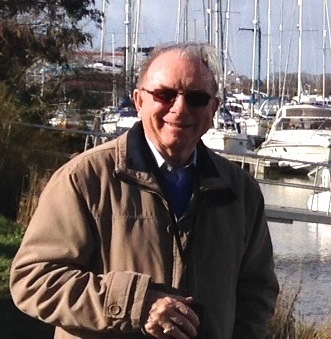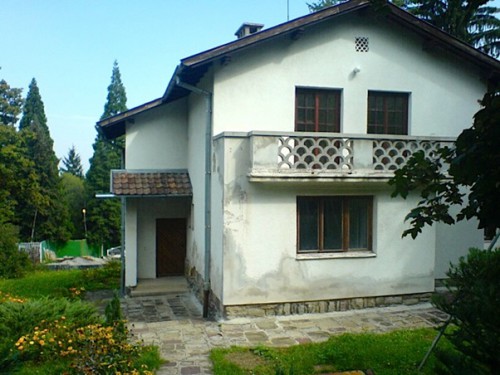13th May 2014 Sofia, Bulgaria
Living in the Boyana Compound in the Early 90’s
by David Stokes
David Stokes was Director of British Council Bulgaria from 1991 to 1997. He was the first British diplomat to stay in a Bulgarian family whilst learning the language. David was also asked by the Ministry of Foreign Affairs to “run the British Council as if it was in Western Europe’”. David and his wife Pepy now divide their time between Ruse, Chichester and their house in the Balkan Mountains.
“I think I prefer to remember the compound as it was without the SUV’s and questionable improvements to certain properties. Yet the changes there (or lack of them) symbolised the transition that was taking place in the country as a whole.” – David Stokes

The Boyana Compound on the outskirts of Sofia consisted of several villas occupied until the end of 1989 by senior government and party officials. It had its own security arrangements and privileged facilities such as a leisure center with an indoor swimming pool and a restaurant where meals could be ordered for home delivery. The main entrance (complete with security guards and a barrier) was in Ulitsa Sequoia and the perimeter fence used to have video surveillance cameras every few hundred meters.
Among the lesser known events that followed the enforced resignation of Todor Zhivkov on November 10th 1989 was the eviction of the old Boyana “residents” and the conversion of the estate to diplomatic housing under the direction of BODK (the Bureau responsible for Diplomatic Premises and Housing). Only Zhivkov himself remained in the compound living under house arrest in a secluded villa near the entrance.
The British Embassy and the British Council were “allocated” four houses for staff accommodation and over a period of seven years I ended up living in three of them.
Driving into the compound for the first time in August 1990 caused some consternation amongst the barrier guards as I was towing a Mirror dinghy but after ten minutes negotiation I was directed to House Number 2. I noticed on arrival that a trench had been dug across the entrance drive without any obvious reason. Three workmen with their hoes were sitting nearby observing life and waiting for the situation to develop. Despite all my efforts and much cajoling they were not going to be persuaded to fill in the trench that day so it became a question of DIY spadework for a couple of hours before it was possible to inch the car and trailer across the gap and reach the garage. I must add however that despite this inauspicious start I later got to know the workers well and they were invariably helpful – one of them used to look after the garden.
I was warned that for the first month or so the telephone connection would be limited. One could ring out through an exchange in the Ministry of the Interior but there was no allocated number for incoming calls. The reason for this was that the local telephone exchange for the compound (situated in an inconspicuous house in nearby Panoramen Pat) needed some rewiring for its new mission. This was largely sorted out before Christmas but there were occasionally times when the signal simply vanished. Although no one was supposed to visit the Panoramen Pat house I found it necessary to do so when the line went dead and used to persuade the “operator” to check his jack plugs and cables to restore communications.
Visitors to the Boyana houses were invariably curious about the perks and privileges enjoyed by its previous occupants. Top of the list came the built-in projection facility for films not shown to the ordinary public in cinemas. Each house had a tiny partitioned room and a stand for a 16mm projector. There was a small glass projection window that could be closed off from the main room when not in use. When some government officials left in 1989 they left behind dozens of mementos of their time in power especially carefully crafted birthday eulogies. One of my favorites was a beautiful model engine set on a short length of track sent by railway workers to a former Minister for his 50th anniversary.
Before the changes there was great concern about a potential nuclear attack so each house had a safe retreat, usually in the cellar near the central heating boiler. Standard equipment included white overalls and headgear, material for sticking to windows for flash protection and the area was enclosed by solid walls and a heavy metal door. I rather doubt that these measures would have been effective in practice but they certainly reinforced the sense of threat from the other side. For my youngest son the best piece of kit was the gas mask and he refused to go to bed unless he had one on his bedside table.
Once the process of restitution started life in the compound became more complicated as previous owners or their descendants appeared out of nowhere to regain their family properties. Judging by the number of people who claimed to have been born in the Boyana houses (at least five for House 2) one could believe that the area had originally been a cluster of maternity homes rather than posh villas. BODK managed to hold on to their diplomatic housing contracts remarkably well but even so some villas had to be given up after intense legal (and not so legal) pressure.
So much has altered these days that it is hard to recognize many of the houses and their gardens. Also it was much quieter in the early 1990’s – at most a twenty-minute drive from Boyana to the Embassy or the British Council. The last time I drove the same route in 2007 it took me an hour and a half.
I think I prefer to remember the compound as it was without the SUV’s and questionable improvements to certain properties. Yet the changes there (or lack of them) symbolised the transition that was taking place in the country as a whole.
